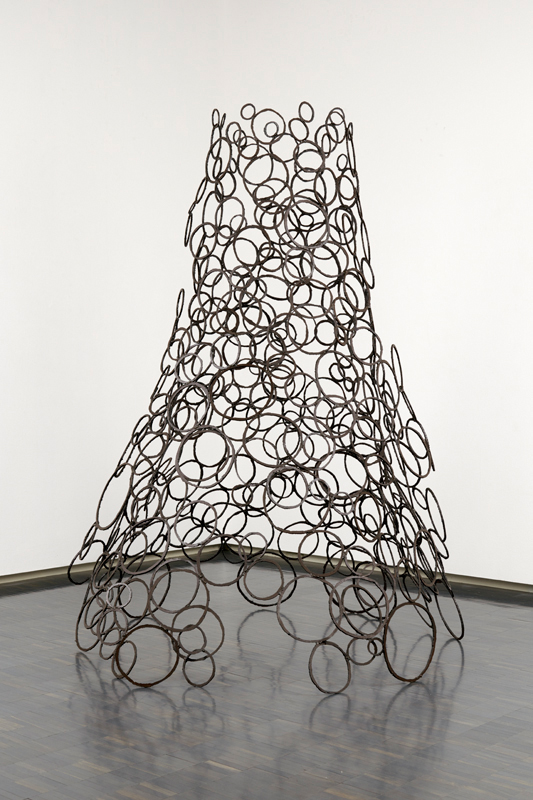Watch, Read, Listen
Recent Additions to the Collection MOMAT Collection Newsletter of the National Museum of Modern Art, Tokyo Aoki Noe, Moya 2018-I, 2018
Back
Moya 2018-I
2018
steel
207.0×163.4×150.0
Purchased FY2022
Photo by Otani Ichiro
Aoki Noe drew a large number of circles in chalk on a thick steel plate, then cut them out with a blowtorch and welded them together. This writer remembers being fascinated when watching the artist’s public production of a work, how she built a structure out of repeated lines, as in knitting. It was astonishing to watch a line drawing evolve into sculpture, to see what had been points, lines, and planes defying gravity and standing up dynamically in space. Largely composed of voids, Aoki’s sculptures are fully liberated from the inherent rough texture, solidity, thickness and heft of steel even as they fully expose the material. This characteristic is derived from the principle of constructive sculpture: not shaping a mass by modeling, molding or carving, but centrifugally expanding a work by forging connections.
Since she was a student in the late 1970s, Aoki has made steel her primary material while exploring light and steam, which as weightless, ephemeral phenomena are diametrically opposed to steel, as subjects. Here, it should be noted that than aiming to represent light and steam directly, the artist employs a production process that evokes these motifs. The viewer of her works experiences a sense of dichotomies such as two- and three-dimensional, large and small, heavy and light, rigid and flexible, and coarse and fine being suspended, and that there is movement back and forth across these boundaries. This character is fundamentally woven into her working method, which begins with hand drawing and evolves into sculpture. It is a fascinating aspect of Aoki’s works that her process of creating the works aligns with our experience of them, making viewing the works tantamount to witnessing their basic principles.
With regard to the Moya series initiated in 2002, the artist has said, “Moya is the name of a mountain in Aomori. After I installed a sculpture there, a dense fog arose and it was almost impossible to see my surroundings, but when I descended the mountain, skies were clear in the town below. At that time I thought I wanted to construct sculpture like mist,”1 and “I wanted to build up something invisible, like water vapor in the air, or like radioactivity.”2 Her emphasis on phenomena that occur only in specific environments, and on the process of “building up,” seem significant. The title Moya (lit. “cloud valley”) is derived from the name of the mountain where the artist once took part in a residency, and the Japanese word moya means “mist” while implying the mimetic word moyamoya, which describes the appearance of smoke or haze. We invite you to enjoy the dynamism and subtlety of this constructive sculpture that draws the surrounding space into it while rising upward like a misty mountain.
[Notes]
- “Sakka no kotoba” [Artist’s Comment], Aoki Noe: All That Floats Down exh. cat., Nagasaki Prefectural Art Museum, 2019, p. 60.
- “‘Kuma to sake ni’ o oete” [On Completing “For Bear and Salmon”], Moya-II exhibition pamphlet, Kumatama Studio, 2003.
(Gendai no me, Newsletter of The National Museum of Modern Art, Tokyo No.638)
Release date :


